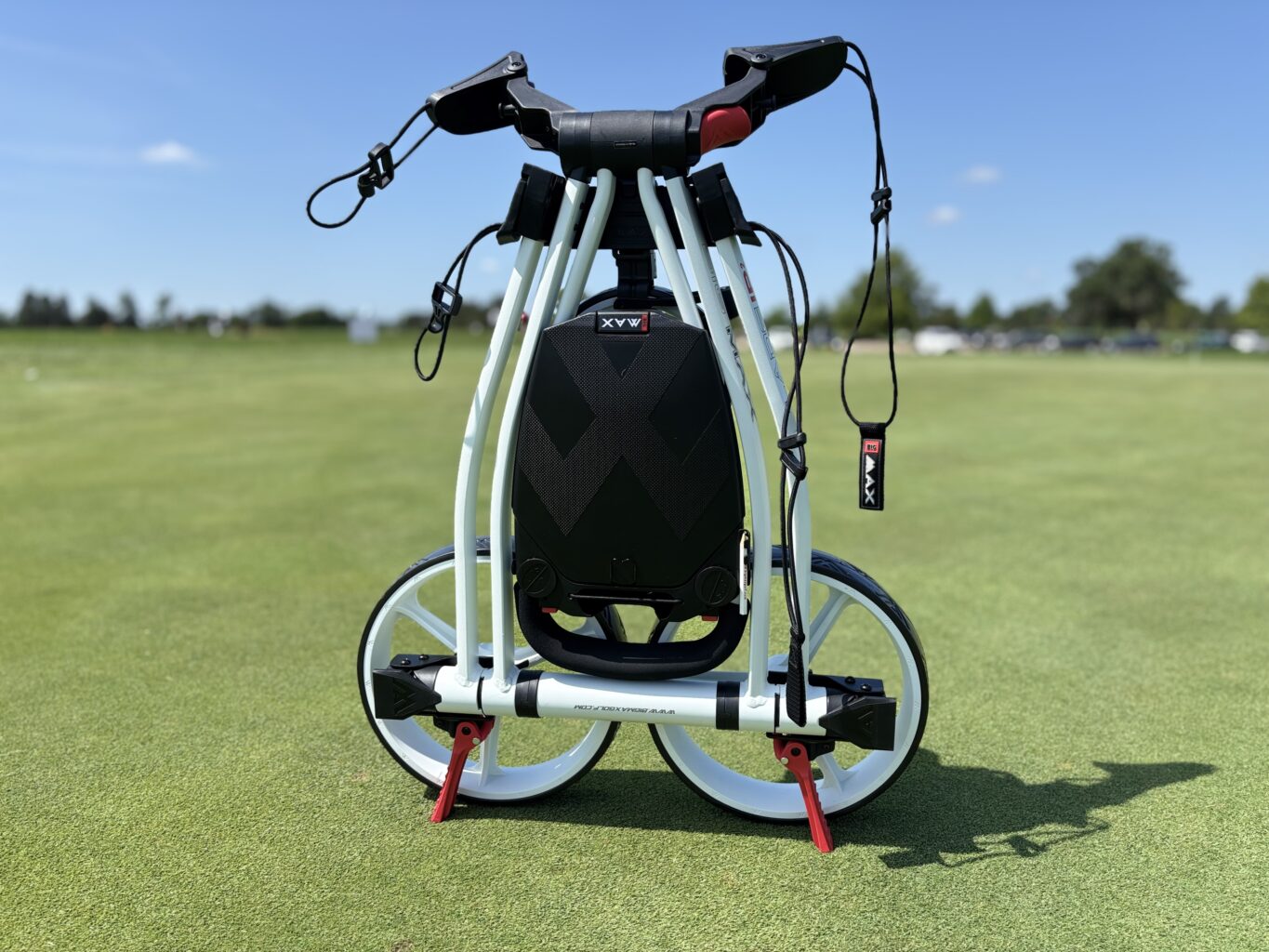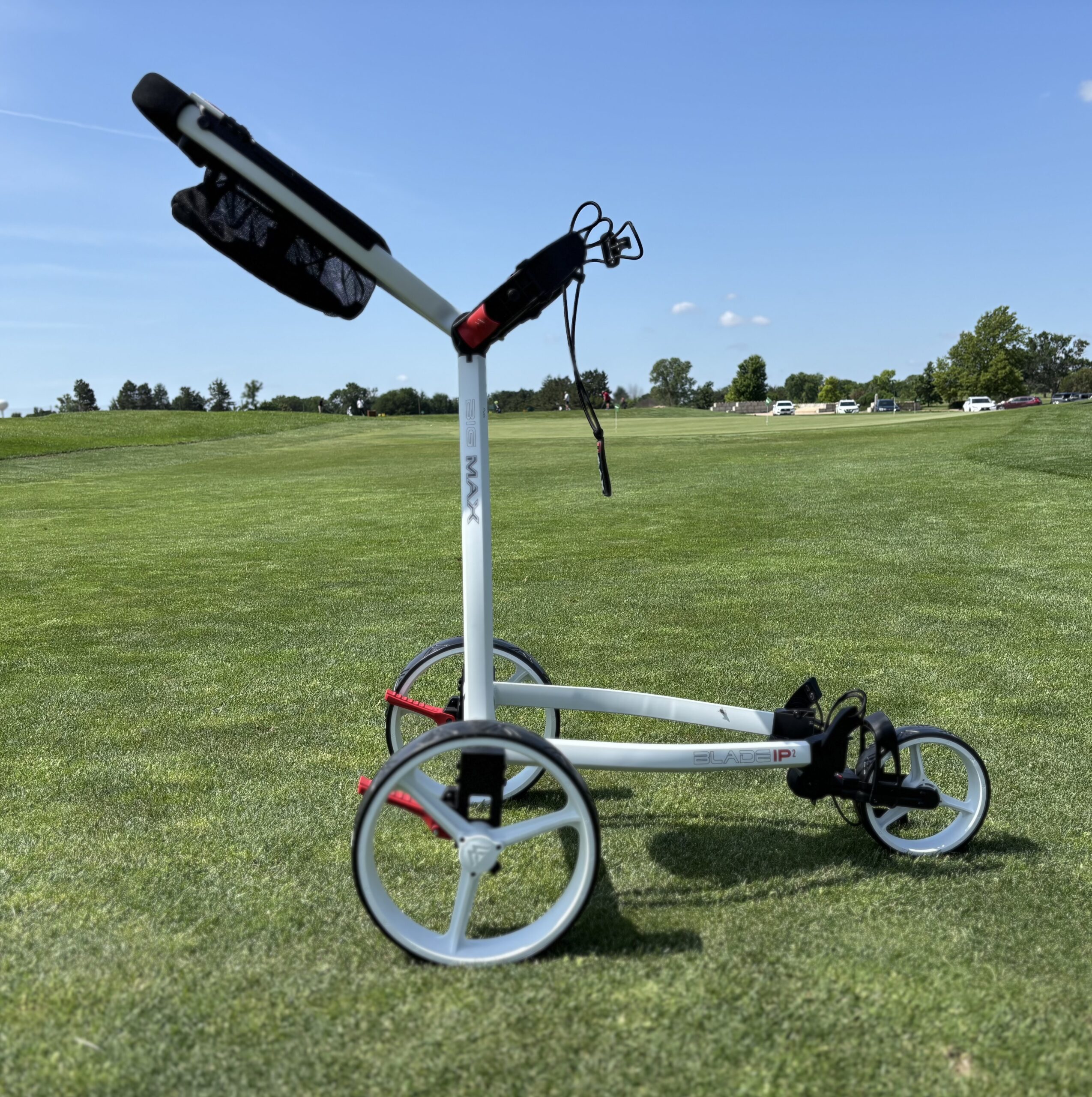The Big Max Blade IP 2 is the follow-up to what was already one of the most compelling push carts on the market. The original Blade IP has for several years now been famed for its impossibly flat fold and stripped-down, travel-friendly design.
It was a minimalist’s dream. A sleek, space-saving solution that delivered serious performance without the bulk or flash of most of its competitors.
This new model keeps the flat-fold brilliance. That core innovation is still very much intact. It still fits places other push carts can’t — trunks, closets, road trips with too many bags and not enough space.
And it still turns heads. Even among gear-savvy golfers, the Blade IP 2 draws curiosity for how different it looks and how uniquely it functions.
But this new version also costs more than the original or other options in the Big Max line. And it comes with some questionable omissions that the OG IP included — namely, the one accessory that arguably defines the push cart experience: the cupholder. For something that’s supposed to represent forward progress, this feels like an odd, almost inexplicable step back.
So we’re left asking, is this really a meaningful upgrade? Or just a slick repackaging of what Big Max already got right?
Let’s take a walk.
Still the Smartest Fold in Golf
The Blade IP 2’s biggest selling point is the same as its predecessor’s, and that’s a good thing. Because no other push cart folds like this.
Where most push carts collapse into a bulky cube, the Blade IP 2 folds flat. Not kind of flat. Not technically flat. We’re talking briefcase flat. Less than five inches thick, it slides into tight trunks and leans easily in crowded closets the way few carts can.
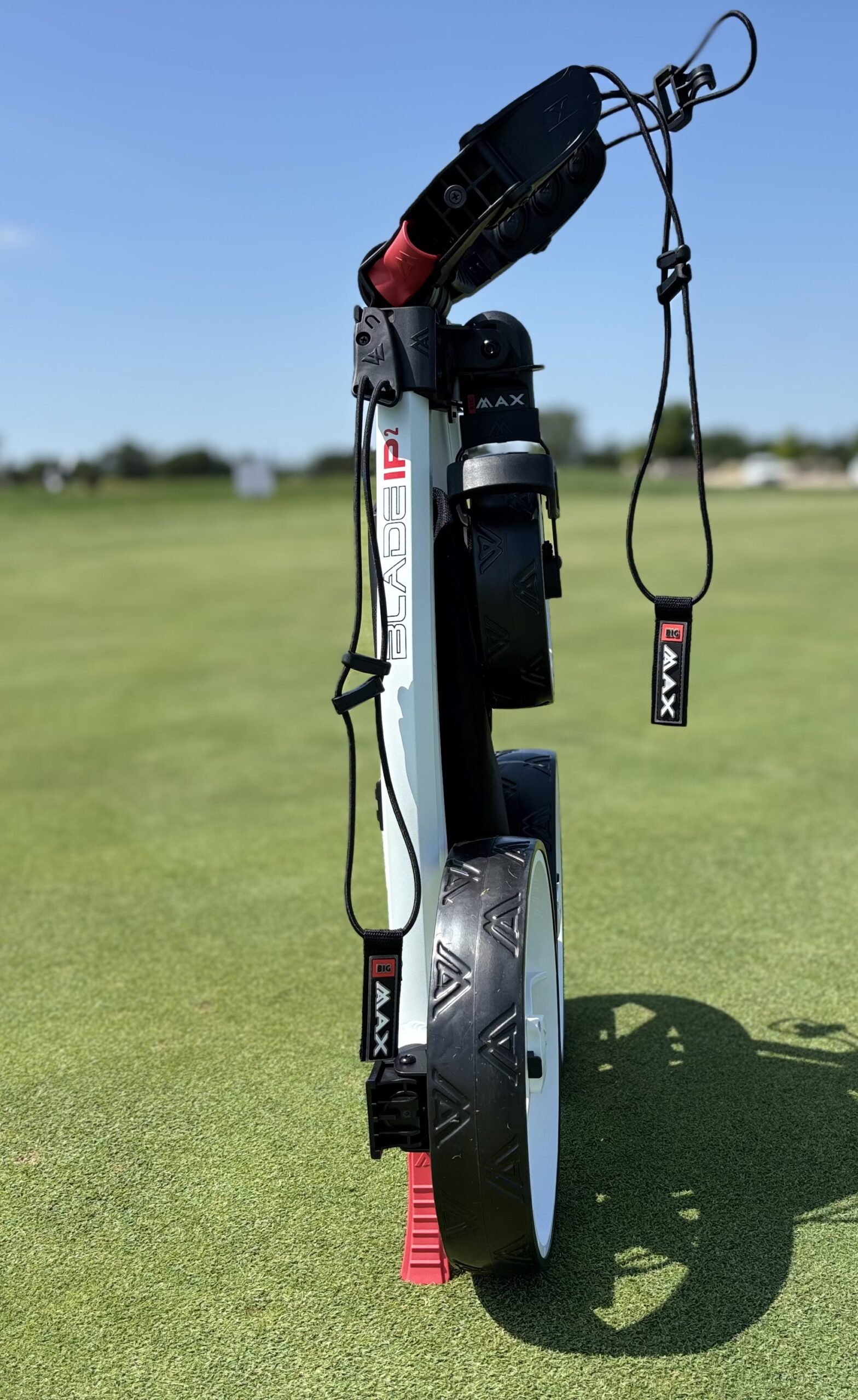
If you’ve ever packed for a golf road trip, you know this matters. A full-sized push cart usually eats up an absurd amount of trunk space. It’s the reason I used to leave mine behind when traveling to destination rounds. Or when picking up buddies on the way to the course. There’s just typically not enough space.
But that’s not an issue with this cart. You can lay it down as a bottom layer or wedge it upright between bags or luggage.
I can’t overstate how brilliant and real-world useful this is. Seriously. I’ve had so many car rides where I’ve wanted to bring my push cart but had to leave it behind.
If you know, you know.
I’m either on a car trip with my family of four, and I’m lucky that there’s even enough room for my clubs.
Or I’m riding with other golfers, and jamming our multiple bags into a tight trunk is already a tough puzzle to solve. A push cart just becomes an unthinkable luxury.
I said something similar when I reviewed the Big Max Blade Trio cart. I just completely fell in love with the flat-fold feature. For my use case, it more than made up for whatever features that cart was missing that were available with competing models.
Well, the Blade IP 2 folds even flatter than the Blade Trio. I never got to use the original Blade IP, but I know from reviewing the dimensions that the folded size is the same with this new model. And that’s plenty good enough for me.
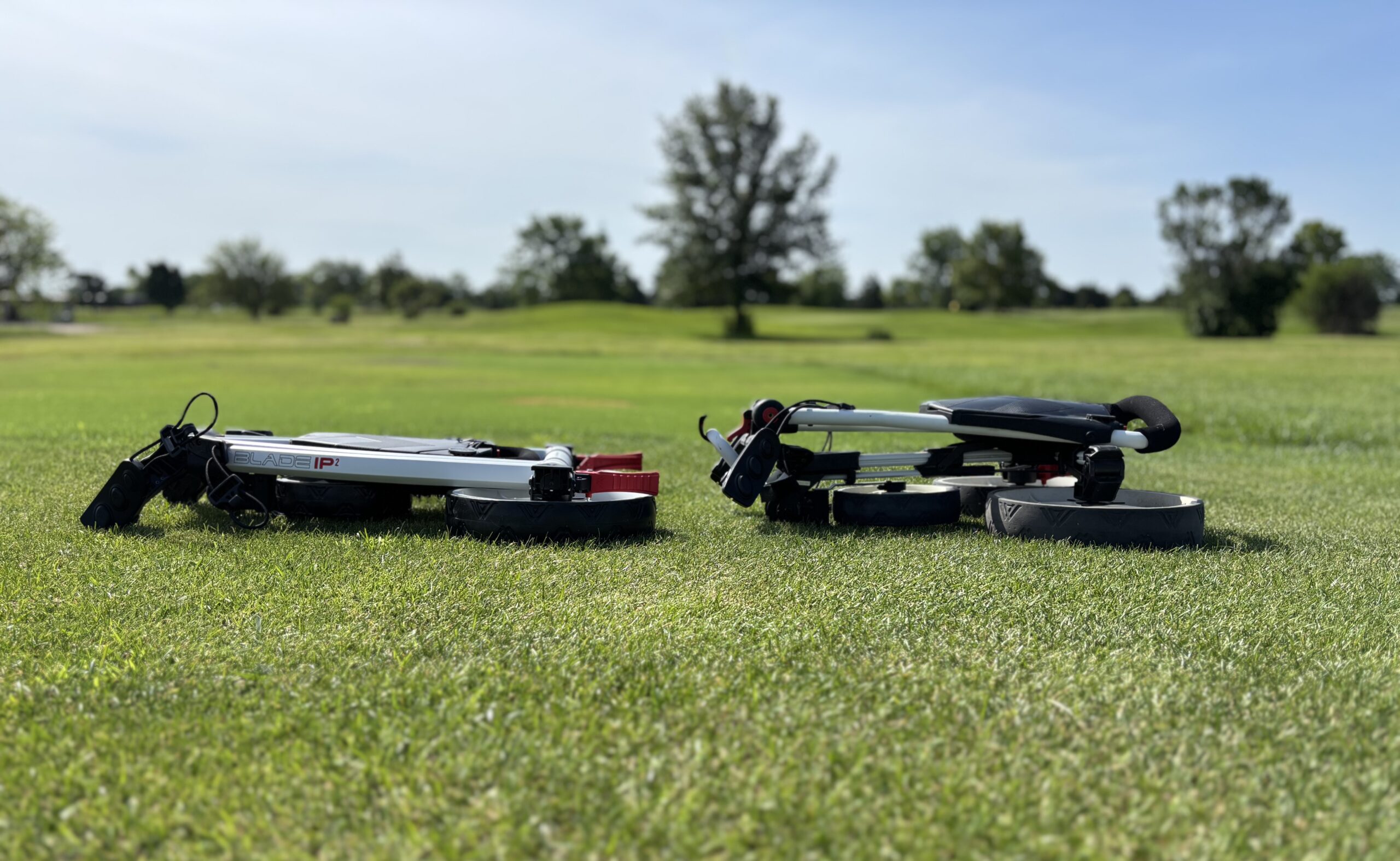
I thought the Blade Trio, at 8 inches thick, was awesome. But these IP models fold down to just 5 inches. That’s insane! That’s three times flatter than something like the Sun Mountain Ridgeline 3, which is actually noted as being more compact than other Sun Mountain carts.
Like I said, I can’t overstate the importance of this flat fold. For me, it’s a game changer. If you envision space as being one of the biggest obstacles to owning a push cart, this cart is the best you’re going to do. I’d stop searching now and just get this thing. It’s worth it for that reason alone.
But that doesn’t mean this is a perfect product. Unfortunately, there are a couple of quirks I find a bit annoying.
This cart folds down to only five-inches wide. That's a huge advantage for anyone with tight trunk or storage space. It also works with any type of golf bag. There's a lot to like. But I sure do wish it came with a cupholder...
What’s New (and What’s Not)
On first glance, the Blade IP 2 doesn’t look wildly different from the original IP. And that’s kind of the point. Big Max knew what worked, so they didn’t rip it up and start fresh. But dig in, and there are changes worth noting.
The material quality, for one, has clearly been upgraded from everything that Big Max released before this. From the wheels to the frame, everything is a bit more polished. A little more premium.
The frame is now built from aerospace-grade, powder-coated aluminum with minimal plastic. When I put it up against the Blade Trio I own, the IP 2 gives off a more refined, modern feel.
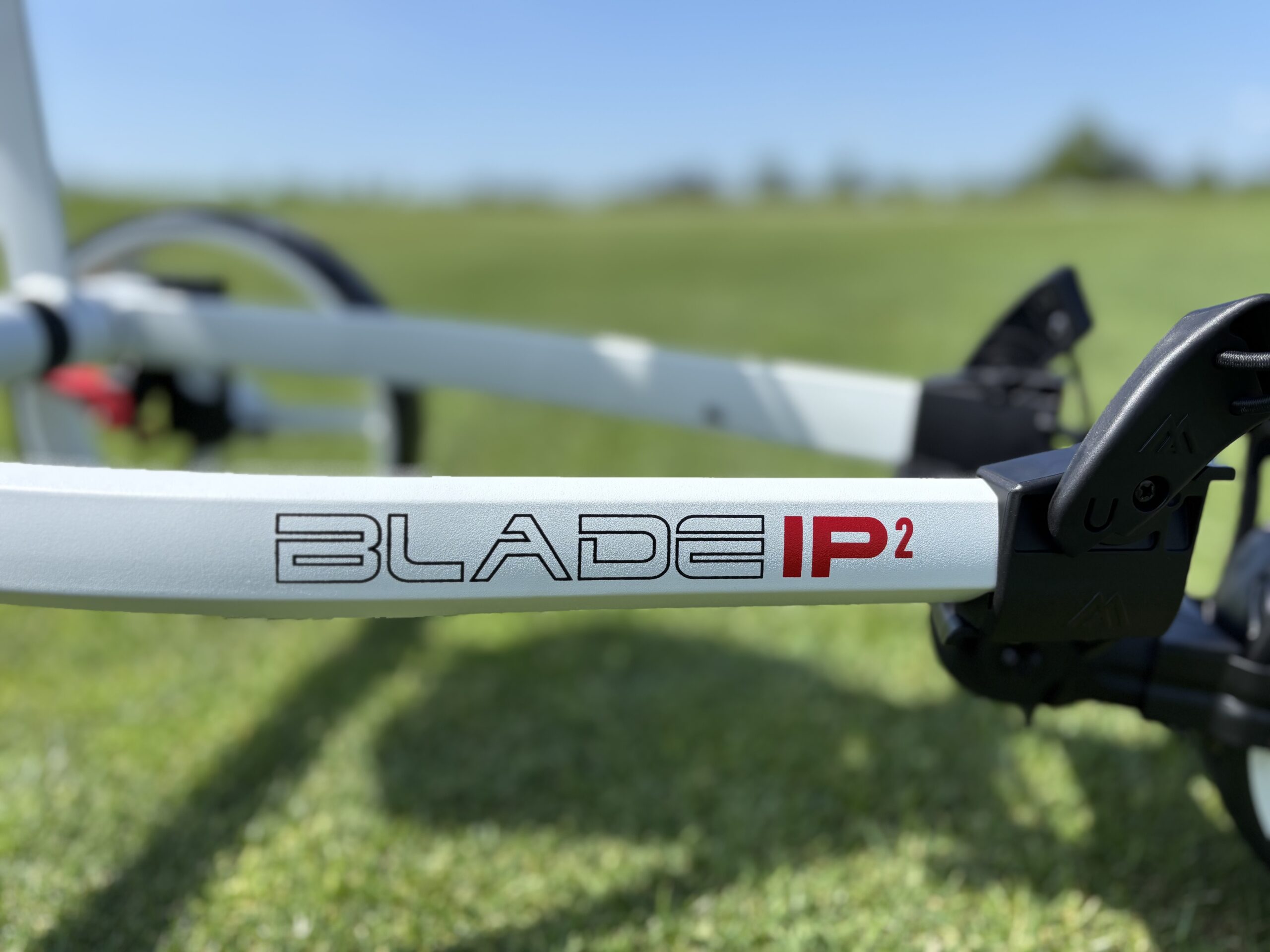
It’s lighter too. The IP 2, at 13.6 pounds, is almost a pound lighter than the original IP and is nearly a pound-and-a-half lighter than the Blade Trio.
That may not sound like a lot, but I can definitely notice the difference in weight when I pick up the Blade Trio and the IP 2 side by side. And as we all know from shopping golf bags and push carts, a pound is a pound. And every bit matters when we’re walking our rounds.
The IP 2 also features an improved storage pouch that’s larger and that includes more internal pockets than what’s on the original IP.

One upgrade with the IP series over the Blade Trio that I definitely appreciate is the dual-foot brake system. Where the Blade Trio has just one rear brake, which can sometimes cause a light pivot if you’re parked on a slope, the IP 2 locks down both rear wheels. Stability improves. And you get the added convenience of being able to hit the brakes with either foot.
I definitely still prefer a hand-brake system to a foot-brake system. I find the hand-operated style to be much easier to reach and just overall superior. But if I’ve got to have a foot brake, I at least appreciate the double-brake option that you get with the IP 2.
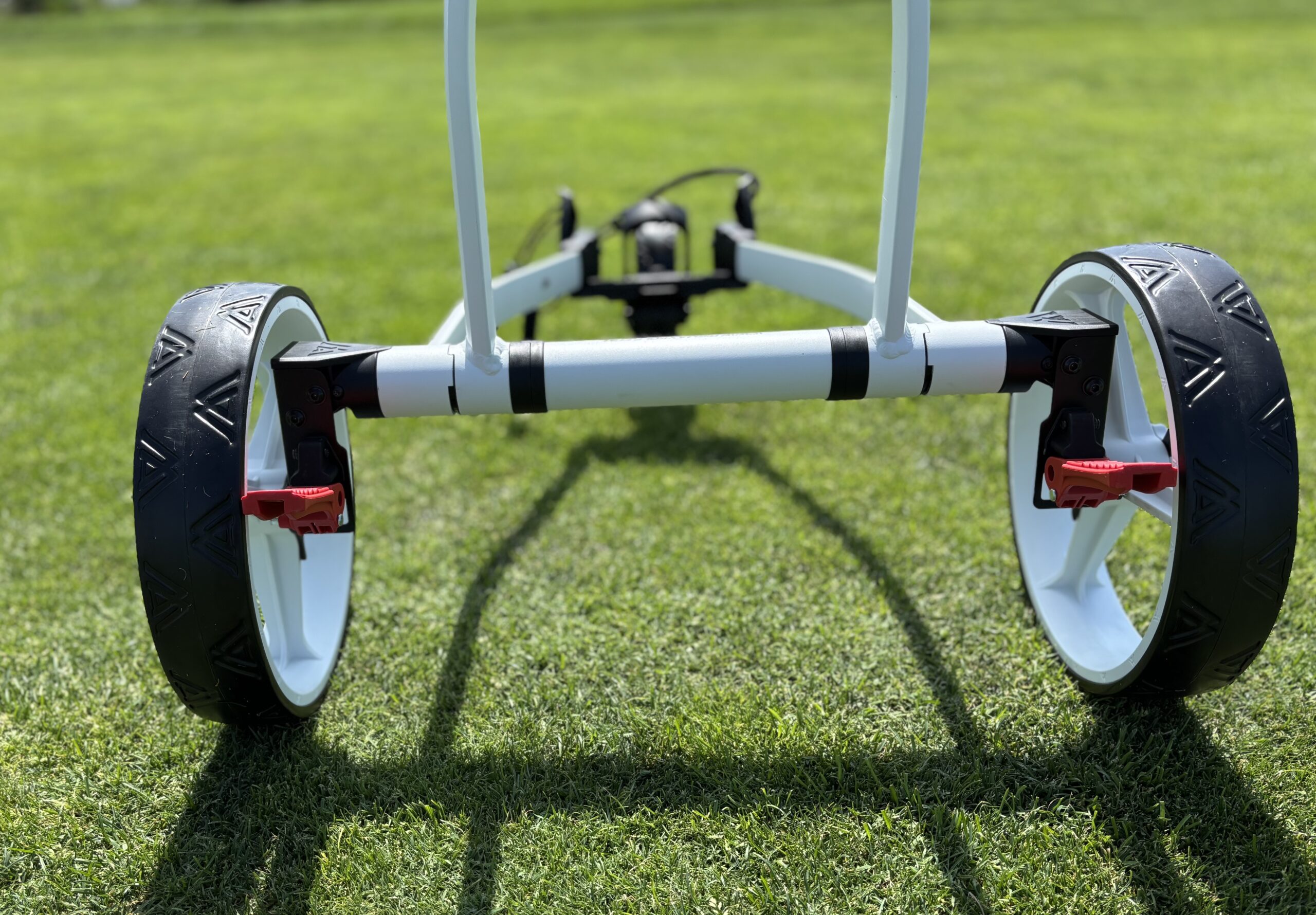
As for the folding mechanism I’ve already gushed about, it’s exactly the same as with the original IP. Again, if it ain’t broke…
The dimensions are also the same, though, as noted, the IP 2 is lighter.
There is one head-scratcher that I’ll dive a bit deeper into in a minute, and that’s the omission of a cupholder. I gotta say, that one pissed me off enough to give it its own section in this review.
But for now, it’s fair to say that while the IP 2 refines some areas, it doesn’t necessarily redefine anything. Meanwhile, the IP 2 costs $50 more than the original IP and a full $100 more than the Blade Trio.
I’ll talk more about those comparisons below. And about how ultimately, depending on how you see things, the IP 2 might either feel like a well-earned refresh or a repackaging that forgot an important essential. Keep reading.
Lightweight Feel, Rock-Solid Stability, and One Very Smart Fit System
I’ve logged rounds with this cart using everything from a full-sized cart bag to Sunday Golf’s El Camino Superlite, a mid-sized bag designed to carry only eight to 10 clubs. And here’s the thing: No matter what I strapped in, the IP 2 carried it beautifully.
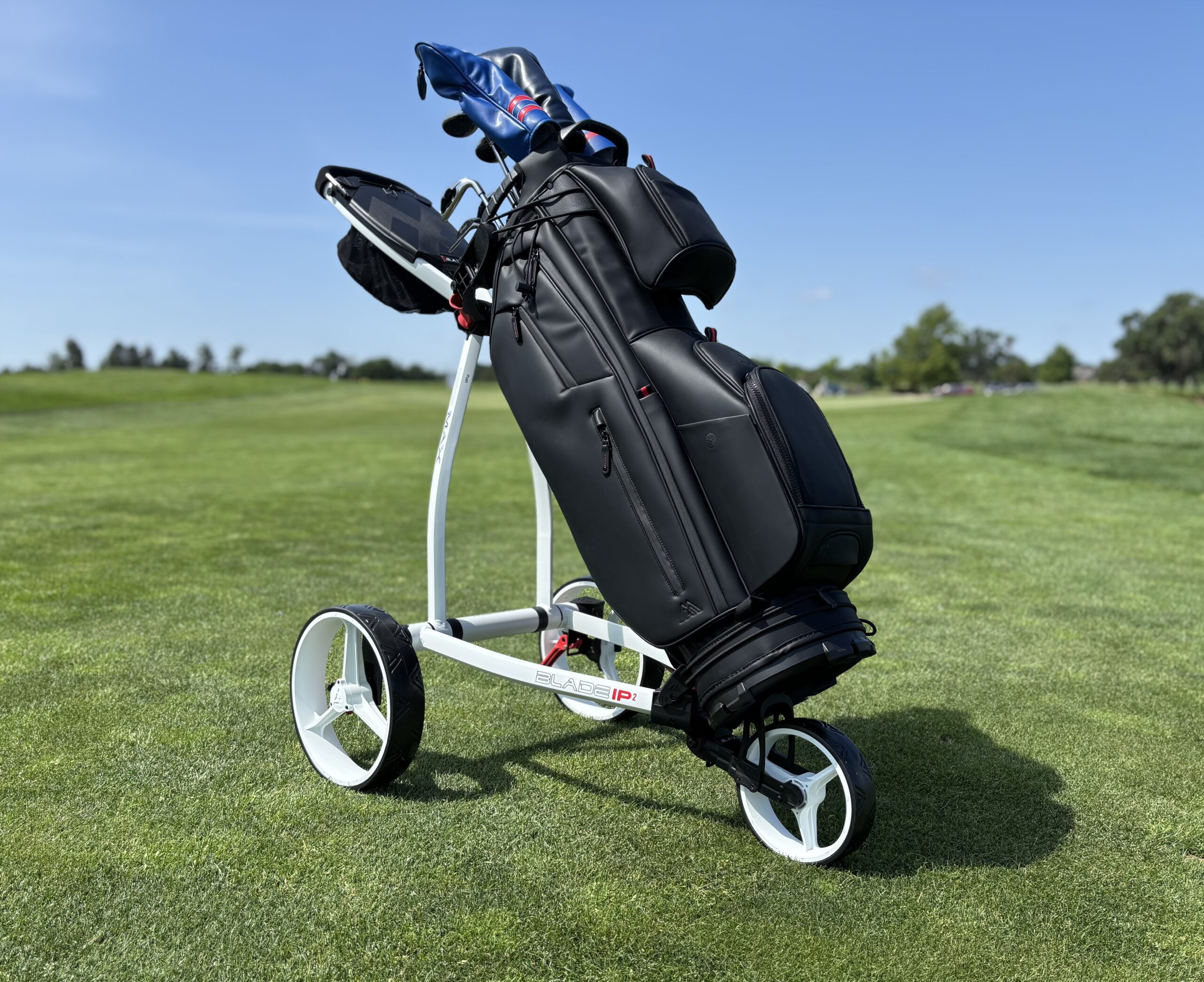
There’s a tendency with lighter, flatter carts to worry that you’re sacrificing bag stability. Not the case here. The bracket and bungee system on the Blade IP 2 work perfectly. It’s actually my favorite style of bracket-and-clasp system. Very similar to the Sun Mountain Speed Carts, if you’re familiar with that popular model.
The top bracket is wide and flexible enough to handle bulky bags, while the flexibility of the bungee system wraps whatever size tight and holds things snug.
I never once felt like I had to baby it or check to see if the bag had shifted.
With both extremes — full-size cart bag and compact half-set stand bag — I walked comfortably and never felt like the cart was fighting me. That’s a real achievement. Some carts feel dialed for a certain bag size or weight. This one is refreshingly versatile.

And the feel while pushing? Smooth. The foam tires aren’t particularly bouncy, but they roll true. And this cart comes with an Allen key and instructions for adjusting the front wheel if you ever notice that it’s starting to pull in one direction.
Again, the lighter weight of this new design is appreciated the more you push it. It never felt like a slog to me, even on longer stretches or uphill climbs. I’ve used some carts that honestly require almost as much energy to push as you’d spend just carrying your clubs. This cart really does take the load off you, which is kind of the whole point of having a push cart.
Now, let’s talk folding and unfolding. It’s definitely very easy with the Blade IP 2, but I actually prefer the Blade Trio’s system. While the wheels still fold in on themselves and everything is mostly automatic with the IP 2, it’s just a step or two more cumbersome than the Blade Trio, which literally just collapses into itself in like two steps.
This is by no means a dealbreaker. Like I said, the IP 2 is plenty easy to unfold and fold. And the more you use it, the easier and quicker it will become.
One more subtle difference: The IP 2 stands vertically on its own when folded, but only if you use the foot brakes as kickstands. That’s a clever piece of design, but not quite as clean as the Blade Trio, which simply stands up on its own without any extra adjustment.
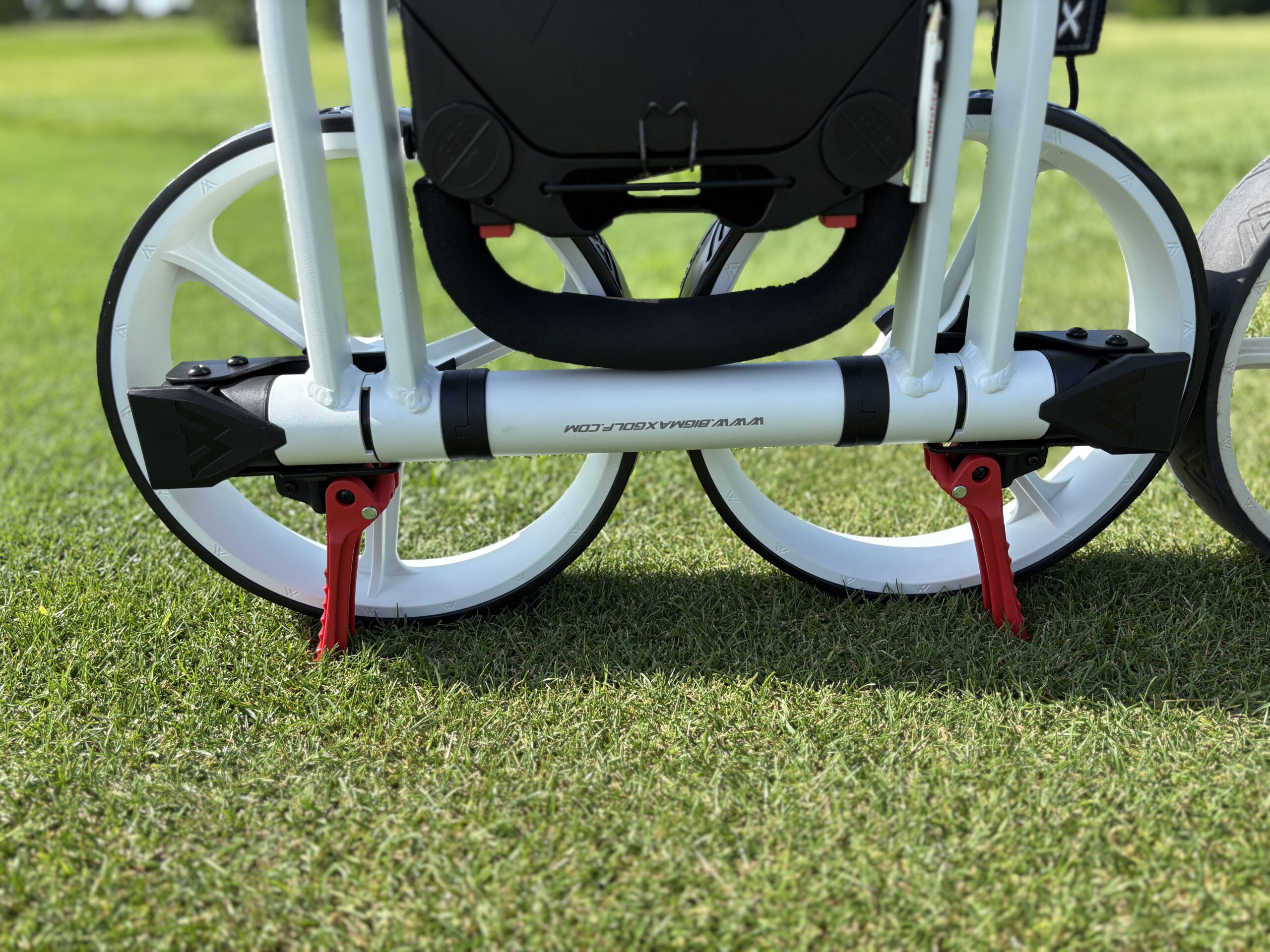
Again, that’s one tiny thing. But it’s one more thing. And that’s always worth mentioning. Especially when we consider that the $399 IP 2 is $100 more than the $299 Blade Trio.
Still, from a walking perspective, the IP 2 shines. You feel the lighter weight. You notice the slightly elevated material quality. You appreciate the balanced carry and the thoughtful touches. And once you’ve used the bungee bracket system a few times, you stop thinking about it entirely. Which is the highest compliment I can give it.
So, cheers to the IP 2. Raise your cup. Wait…
This cart folds down to only five-inches wide. That's a huge advantage for anyone with tight trunk or storage space. It also works with any type of golf bag. There's a lot to like. But I sure do wish it came with a cupholder...
Cupholder Confusion — A Strange Step Backward
This one stings a little.
The original Blade IP came with a built-in cupholder. A simple, perfectly functional, right-there-when-you-need-it accessory that did exactly what you wanted: hold your drink while you walked.
To me, a cupholder on a push cart is secondary maybe only to the wheels themselves. I mean, seriously, one of the great advantages of pushing is that you’ve got a place for your beverage. Beer, water, coffee — they’ve all got their places in my rounds.
When you carry your bag, having a drink with you is a pain. You’re constantly setting it down, picking up, realizing that you forgot it, going back to retrieve it. The push cart solves all of that, and it’s one of the reasons I’m fully push-cart converted.
No cupholder on the Blade Trio was one of my biggest complaints with that cart.
But Big Max got it right with the original IP. They had the cupholder. But now with the should-be-better, more expensive IP 2? No cupholder. And I’m not impressed.
One of the selling points of the supposedly improved IP 2 is that there’s more storage space. Really, all they did was take the pouch that’s on the Blade and now add it to their newest IP. Plus, they included a built-in phone holder.
But it’s right where this now-larger storage pouch is that the cupholder on the original IP used to reside. So, the tradeoff is that you now get more storage but no cupholder. But I think that they could have figured out a way to include both.
You can add a plastic clip-on cupholder to your IP 2 as an after-market accessory. They charge you $15 for it, which just feels like a slap in the face to me. Just give me the damn cupholder with purchase and I’ll shut up. But making me place a separate order and charging me extra for a cheap piece of plastic? Come on, Big Max.
In the grand scheme, no, it’s not a dealbreaker. But it is a head-shaker. And in a cart that otherwise gets so much right, it’s exactly the kind of miss that sticks with you. Or at least it has with me.
Speaking of add-on accessories, Big Max sells a bunch of them. An extra basket that attaches under the cart, an umbrella holder, a sand bottle, on and on. And the cart is designed so that any of those things can either clip or screw into places that are already designed for them.
Blade IP 2 vs. Blade Trio vs. Original IP: Who Should Get What?
Let’s zoom out for a second. Because if you’ve made it this far, you’re probably not just interested in how good the Blade IP 2 is, you’re wondering how it compares to the other Big Max options that look strikingly similar.
To me, the takeaway isn’t necessarily what Big Max wants you to think it is.
The original IP was a minimalist marvel. It was light, it folded flatter than anything else, and yes — it had a cupholder. It lacked some of the modern polish, and its construction wasn’t quite as robust as this improved version. It was also slightly heavier than the new option. But it nailed the mission of being compact, clean, and functional. And it was priced at $50 less than the new IP 2.
The Blade Trio, on the other hand, was like the value alternative. It was $50 less than the original IP, which means it’s now $100 less than the new IP 2. No, it doesn’t include a cupholder, which sucks. But it still folds impressively flat (though not quite IP-flat) and still feels sleek and modern.
The folding mechanism on the Blade Trio is, frankly, easier and quicker than the IP 2’s.
The Trio is heavier, but not dramatically. In fact, it’s heavy enough to feel durable, but not so much that it becomes a chore.
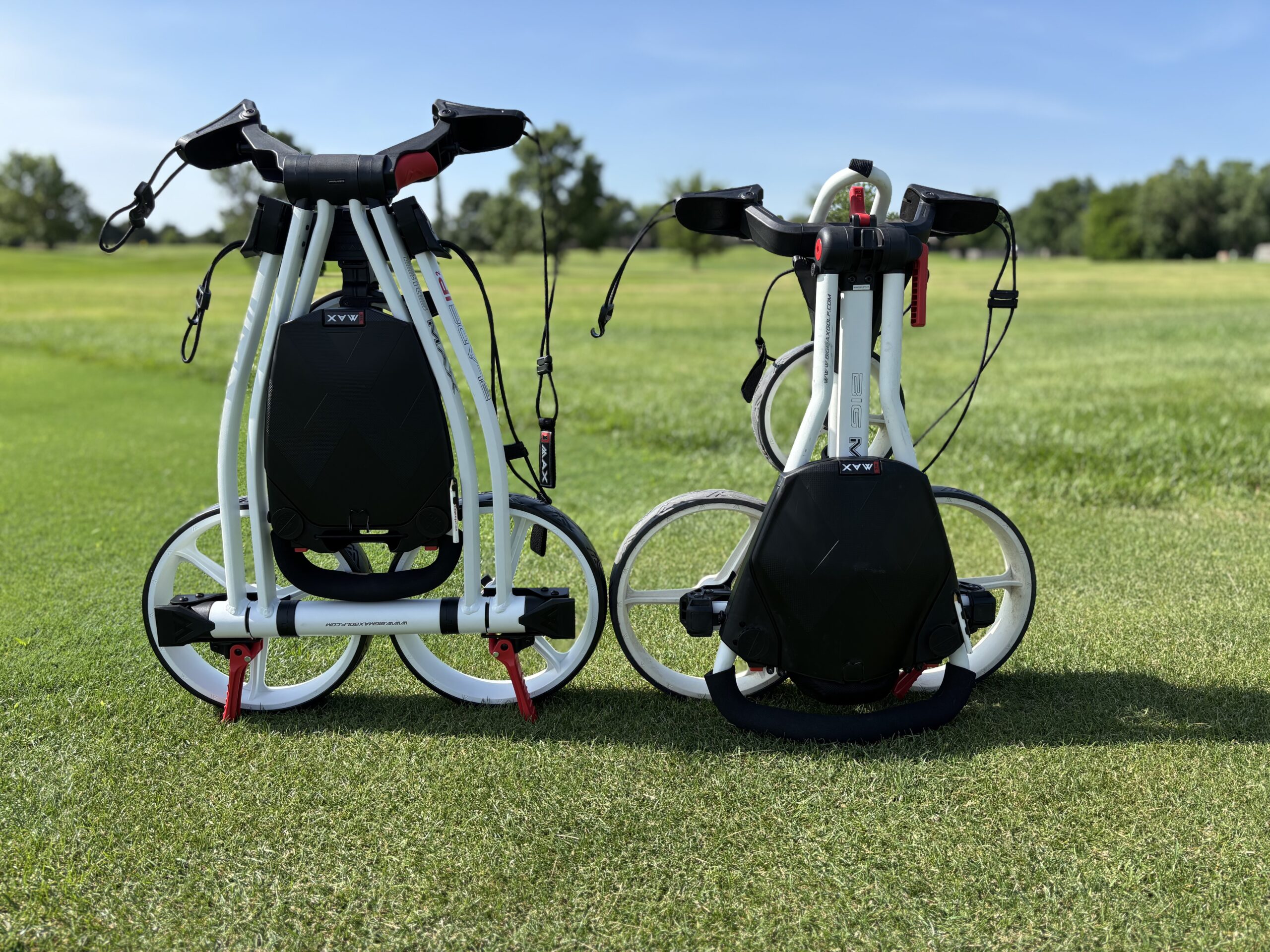
Now enter the Blade IP 2. It’s the most premium of the bunch, at least in price. And yes, the materials are upgraded. The whole frame feels tighter, smoother, lighter. It’s the nicest feeling cart in the line. And it folds flatter than the Blade Trio. It’s got the same increased storage as the Blade Trio. It also retains the dual-foot brake system that the original IP had but that the Blade Trio does not.
So, which one should you get?
Honestly, I’m not sure that Big Max did enough to justify spending more for the Blade IP 2.
Now, don’t get me wrong. I actually love this cart. In fact, I’d encourage anyone interested to buy with total confidence. I think that it’s definitely the best cart in the Big Max lineup.
What I’m saying is that, for $50 less, if you can find one, the original IP does about the same thing almost just as well. Not to mention, they throw in the cupholder.
Or, for $100 less, you can get a slightly heavier, slightly thicker cart in the Blade Trio. You’ll only get one foot brake, and you’ll still have to buy your cupholder as an add-on accessory, but it might make sense to save the $100. I’m not sure you’d really miss the advantages that the IP 2 provides.
So, am I saying that the Blade IP 2 isn’t worth buying? Absolutely not. I think it’s an excellent product.
All I’m saying is that the other, less-expensive Big Max carts are also excellent products. So, if you’re on a budget, I’d go with one of those options. If, on the other hand, you just want to get the best one and not second guess anything, then, yes, get the new IP 2.
None of these carts are bad choices. They’re all strong. But in a world where push cart design is finally seeing real competition and thoughtful innovation, details matter. And price matters too.
Final Big Max Blade IP 2 Thoughts
At the end of the day, the Big Max Blade IP 2 is a push cart that almost entirely delivers on the promise of refinement. It’s light, slick, and thoughtfully engineered.
That impossibly flat fold remains a marvel, not a gimmick, and it unlocks real-world utility that no other cart that I’ve used can offer. For anyone who’s ever juggled bags in a cramped trunk or skipped their cart altogether because it just wouldn’t fit, this cart solves that problem.
It also just feels nicer than what came before. The upgraded materials, the clean construction, the subtly improved performance all add up to a cart that looks and behaves like a premium product.
But it’s not flawless.
The lack of a cupholder, especially when the previous version had one, is a genuine whiff. It’s the kind of decision that makes you scratch your head and wonder whether anyone who actually walks with their cart had a say in the final spec sheet.
And while the folding process is still plenty easy, it’s just a touch less elegant than the Blade Trio’s in my opinion.
So where does that leave us?
If price is no object and you simply want the best Big Max cart available, this is the one. The IP 2 earns that title. It’s the cleanest, flattest, most premium feeling model they’ve built to date.
But if you’re trying to stretch your dollars, or if you already own the Blade Trio or original IP, you’re not missing out on a quantum leap here. The gains are real but modest. The quirks are few but memorable. All in all, the value proposition is solid but not unassailable.
If you’re after the sleekest, smartest (other than the lack of a cupholder) version of a push cart that already got so much right, the Blade IP 2 is exactly that. It doesn’t reinvent the concept, but it pushes the idea of what a cart can be.
This cart folds down to only five-inches wide. That's a huge advantage for anyone with tight trunk or storage space. It also works with any type of golf bag. There's a lot to like. But I sure do wish it came with a cupholder...
Big Max didn’t break what wasn’t broken. But did they really build on it?
The Big Max Blade IP 2 is the most premium-feeling flat-fold push cart in the Big Max lineup. It's impressively light and brilliantly compact. But for all the polish, the missing cupholder and a few usability quirks hold it back from perfection. Still, it's an excellent choice for golfers who prioritize space savings.
The Good
- Still the flattest fold in the game
- Upgraded materials feel premium
- Dual-foot brake adds stability
- Increased storage is practical
The Bad
- No included cupholder, despite being the most expensive model in the line
- Folding process slightly less intuitive than the Blade Trio
- Foot brake system is functional, but some may prefer a hand brake
-
Presentation
-
Performance
-
Features and Quality
-
Price
-
Personal Affinity

